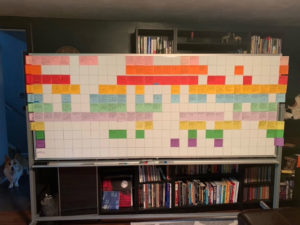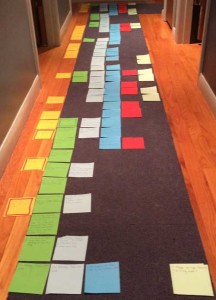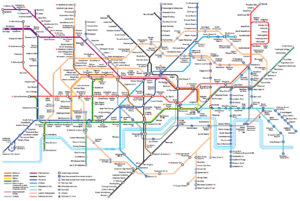The Plot Rainbow is Like The London Tube Map
![]() One of the techniques we rely on heavily for our pre-writing process is the rainbow. It gives us a map to follow. Each row uses a color to represent a character, and the columns reflect the passage of time. Because our stories tend to be large and complex, our rainbows can get pretty unwieldy, taking up the entire hallway, and, more recently, forcing us to use both sides of our ginormous whiteboard.
One of the techniques we rely on heavily for our pre-writing process is the rainbow. It gives us a map to follow. Each row uses a color to represent a character, and the columns reflect the passage of time. Because our stories tend to be large and complex, our rainbows can get pretty unwieldy, taking up the entire hallway, and, more recently, forcing us to use both sides of our ginormous whiteboard.


The power of this tool is that it helps us visualize the flow of the story, to spot characters who are underutilized and debug the timing of events. It’s proven itself to be well worth the hassle. But, keep in mind that the rainbow isn’t a calendar. The objective is to focus on the important beats, which means the columns’ durations are all likely to be different. The rainbow distorts time in a manner reminiscent of how the map of the London Underground distorts space.

By discarding concern for geographic accuracy, the London Tube Map becomes more meaningful by showing more stations. Riders need to know which stations are on each line, and in what order. That’s enough for them to use the system to get where they’re going. Do the people riding the tube sometimes need more spatially rigorous information about these places? Surely. That’s just not the job of this particular map. Likewise, writers do sometimes need specific dates. Fortunately, we have calendars for that.
That the columns of the rainbow grid aren’t fixed units of time is not a bug. It’s a feature. But like any other part of the process, having an extra pair of eyes will definitely come in handy to make sure everything’s lining up. A writing partner is someone to help you keep all your stations on the proper lines.
